Copyright 2023, Castenholz and Sons
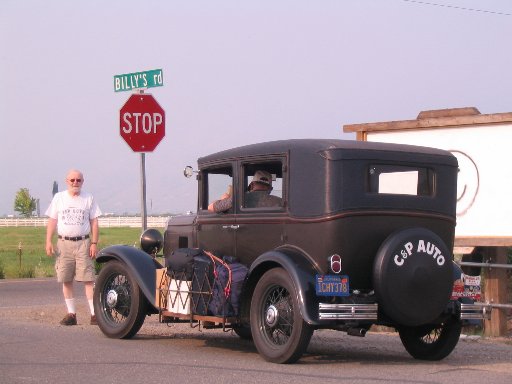
Billy Possum back on the road. Bill & Mike (in the car) in Minden, Nevada.
If you were to compare Mike's 1930 Chevy with Bill's 1929 you would find quite a few differences.
In studying these cars we have found that much of the 4 cylinder technology was used in the 1929 cars. In the first 6 cylinder engines the oil pumps were of about the same capacity as the late 4 cylinder engines. Midway through 1929 the oil pump capacity was increased. It was increased again at the beginning of the 1930 year models and yet again in 1932.
In 1929 the rear service brakes were external contracting, having been changed only slightly from the 1928 models. The front brakes were almost identical with the previous year. Except for length the 1929 propeller shafts is identical with the 1925-1928. The axles are identical from 1925 to 1929. So in many ways the technology of the late 4 cylinder cars was carried forward into 1929. The gas gage on the 1929 car is located at the gas tank, with a hole provided in the gas tank cover for the gage to be seen. In 1930 the gas gage is part of the instrument panel, having been moved inside for convenience.
In 1930 the axles and propeller shaft were beefed up. The brakes are internal all around. And they are larger. Only 1 cross shaft controls the brakes. In 1928 and 1929, two shafts were used. But the most important changes are in the engine. By increasing the intake valves by 1/16th inch and decreasing the exhaust valves the same amount the valve spacing remained the same but the engine power went from 46 to 50 hp. That doesn't sound like much but it is almost 10%! Actually the valve changes allowed the engine to run at a higher rpm and that allowed the rear axle ratio to be lowered from 3.78 in 1929 to 4.11 in 1930. The result was a car that could travel just as fast but with better acceleration and better hill climbing capability.
In comparing the cars on the outside, small differences are noticeable. The windshield on the 1929 is almost straight up and down. On the 1930 the windshield slopes slightly. This seems minor but at night the lights from a car in the rear of the 1929 reflect off of the windshield glass and directly back in the driver's eyes. The change in 1930 corrected that problem.
A big difference you would see in comparing Mike's 1930 with Bill's 1929 is that the 1930 car is in a lot nicer condition. It has the original paint on the body (the fenders have been repainted in the original black lacquer), the upholstery is not only original but in very nice condition. The mileage is in the 60,000s. Bill's car turned 100,000 a couple of years back. The feel of the doors is very solid on the 1930. In general it is a nicer car, not to mention that it is a Club Sedan. Bill's car is a standard 4-door sedan.
All of this is well and good but "Bomber," Bill's 1929, has one big advantage. It will go anywhere anytime with (generally!) no problem. Bomber has been to over 25 states, including going to Oregon, to Indiana, down to Georgia, back to Colorado and then home to California. It has been to the top of Mount Palomar, the home of the 200" telescope. It has been across the Sierra Nevada range at least a dozen times. In all, Bill has driven the 1929 over 65,000 miles!
Mike's car, on the other hand, has had cooling problems on a regular basis. Purchased in Minneapolis and driven home to Los Angeles, it overheated until we had the engine and radiator flushed out in Nebraska. Last year, in attempting to go to "Hot August Nights" in Reno the car overheated going up the Sherwin and Conway grades on Interstate 395.
However Mike flushed the engine out with caustic soda and prepared it for this year's journey to Minden, Nevada. No more heating problem! So we thought!!
Regularly we have 4 passengers. Mike and Bill sit in front and, because Bill's wife Jeanette was not going on this trip, there was room for two of the grand kids in the back (there are seat belts there). We use a priority system and for this trip Baxter and Matthew were going. Matthew had been on several of our recent trips. This was Baxter's first car trip in Bomber.
Baxter was already at Grampa Bill's house on the day before the trip began. Matthew would be picked up the following morning.
Nathan is Matthew's older brother. He won a gold medal in mathematics in the Skills USA California State competition. The next step was the national competition in Kansas City. Nathan would be going to LAX at 4 am for his flight to KC on the very same day that our trip to Minden was to begin. If Matthew rode with Nathan we could pick him up at the 405 Freeway and save a lot of driving. The only problem was being at the freeway at 3:35 am!
So it was decided that Mike would stay overnight at Bill's house and thus save getting up an hour earlier. Also Betsy wasn't running quite right and the boys wanted a chance to fix what was wrong before starting on the trip.
Sunday, Day Minus One
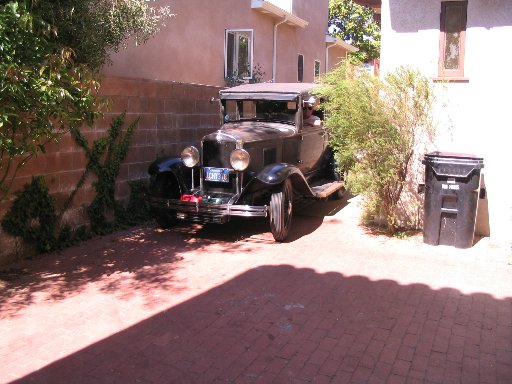
The day before the trip was to begin. Mike arrives at Bill's house.
Mike arrived at Bill's Sunday afternoon and the boys soon were checking out Betsy. Although at first the carburetor was suspected a check of the timing revealed the problem and within no time Betsy was running much better. The '30 was now ready to go.
Monday, Day One
Reveille was at 2:45 am. The final packing of our clothes bags on the driver's running board was finished and off we went. The time was 3:15 am.
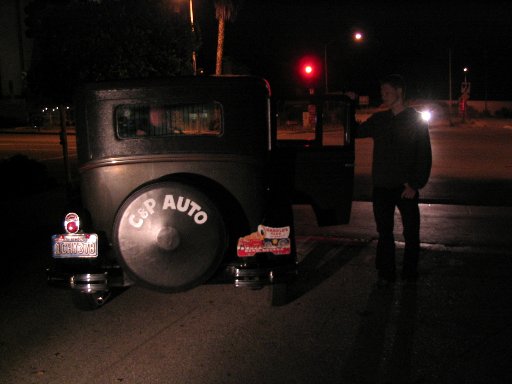
The trip has already begun. Waiting for Matthew to be dropped off, at the 405 Fwy. Time: 3:35a.m.
Sunset Boulevard takes about 15 minutes to get to the 405. Within a few minutes Tim, Nathan and Matthew arrived, Matthew's bag was put on the running board, and off we went, headed north on the 405. Tim and Nathan continued on south to LAX on the 405.

Another desert sunrise - out on the Mojave. The haze is actually smoke from the raging California
fires of this week. There were hundreds of fires in the Sierras during our trip.
This part of the trip is always an exciting time. We were finally on the road after a lot of planning. Although it was dark, it would only be a short time before the dawn would begin and then another sunrise on the road! We were on the Mojave desert when the sun came up and the day officially began.
Breakfast in Mojave at Denny's and a fill up at $4.559/gal. (ugh) and then back on the road.

Red Rock Canyon has always been a welcome sight. It is the only significant landmark
between Mojave and Little Lake - a total distance of 66 miles!
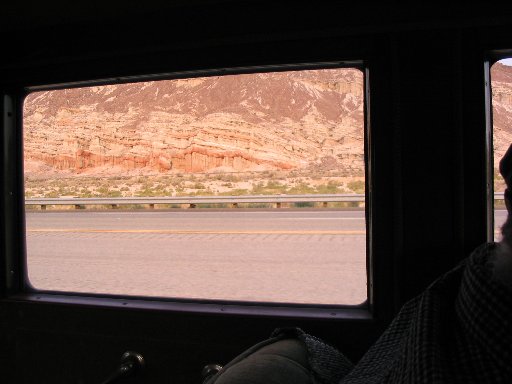
Passing Red Rock Canyon, the site of so many cowboy movies. Even today it conjures up
the imagination of Tom Mix or Bob Steele chasing the bad guys around the mountains.
Red Rock Canyon is the only "event" between Mojave and the tiny town of Little Lake - a distance of 66 miles. In the past Little Lake was also an "event" with its restaurant and gas station. As a kid, traveling with my Dad I remember being fascinated with the penny board in the Little Lake gas station glass counter, filled with all sorts of old Lincoln cents. Now Little Lake is bypassed by Interstate 395 and Red Rock is even more of a punctuation mark in the otherwise monotonous sagebrush.

Matthew found it difficult to contain his excitement of going on another Billy Possum trip.
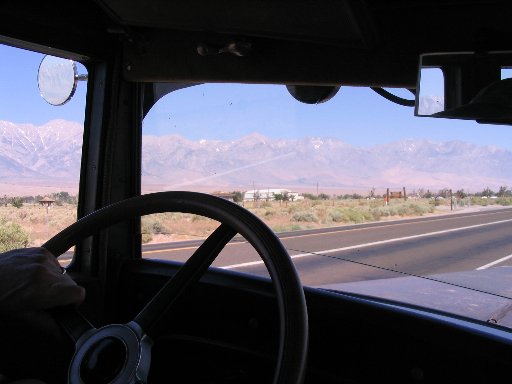
Passing Manzanar, the site of one of the internment camps for Japanese Americans during WWII.
Continuing north on Interstate 395, we soon began to see the Sierra Nevada range rising to our left. We passed Manzanar, the WWII relocation center for Japanese Americans who were uprooted from their homes and way of life to be placed in camps where, supposedly, they would not deter America's war effort against the Japanese.

Our first sign of continuing overheating - Sherwin Grade north of Bishop.
We chose the new road this time, rather than the old one with all of its switchbacks.
One big advantage of leaving so early is that we missed a lot of the lower desert heat. Towns like Olancha, Lone Pine, Independence, Big Pine seemed to go by more quickly because we got an early start. We arrived in Bishop before noon, had lunch, and then proceeded to the base of Sherwin Summit.
We soon knew that the problem of overheating that had plagued us on the similar trip of last year was not solved! After three stops on the grade in order to let the engine cool down, we were able to find the best engine speed in 2nd gear, and using the choke for cooling, we reached the summit without any further stops.

A stop by Crawley Lake: coolant for Betsy, coolant for Baxter and the others (in the form of ice cream).
We made a rest stop at Crawley Lake. Then we were quickly back on the road, passing the Mammoth Mountain turnoff and proceeding to Lee Vining and Mono Lake.
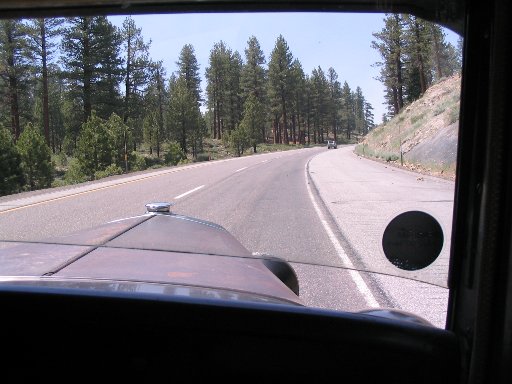
Approaching Dead Man's Summit. Here is a short section of beautiful fir trees.
A stop in Lee Vining for groceries and some soap for the radiator only took a few minutes and we were on the road again. It took several stops to let the engine cool but we reached the top of Conway Summit and continued on into Bridgeport. We were low on gas but the Bridgeport prices made us wince so we got a bit over 2 gallons (at $5.299) and headed for Topaz Lake and the Nevada Border, hoping that the gas prices would be better. They were!
We filled up the gas tank in Topaz, Nevada, at $4.159/gal. - that's $1.14/gal. cheaper than in Bridgeport, California, only about 40 miles back!
After dinner in Minden we drove out to Lester Harris' house where we were to spend the next 3 days.
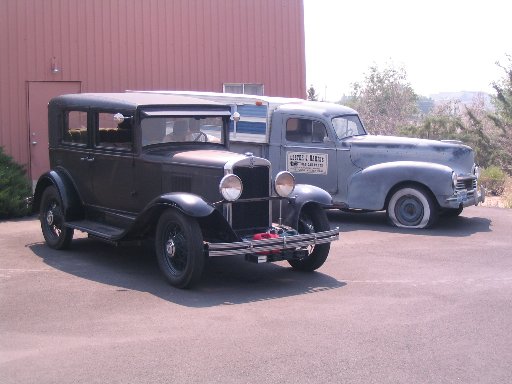
Arrival at Lester Harris' house. Lester is always a very gracious host.
Lester has the largest inventory of obsolete auto parts that we know of.
Tuesday, Day Two
For old car enthusiasts like us Lester Harris' place is like a candy shop. But first we must start the day off right. The boys were off hiking so Mike and Bill headed to the nearest Starbucks. We also had to stop at the local parts store for some oil and plastic gloves. Then we were ready to hunt for old Chevy parts!
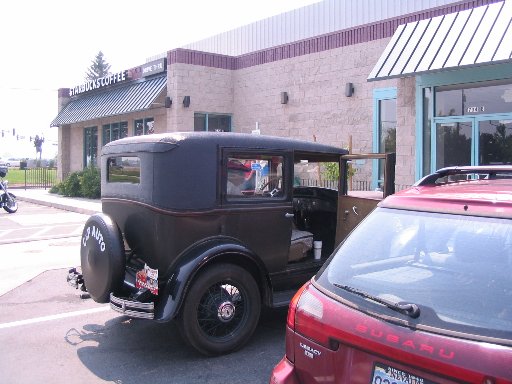
The Starbucks in Minden, Nevada. Starbucks has become an essential part of our recent trips
despite the fact that the cost of a cup of coffee seems to keep up with the price of a gallon of gasoline.
We began in Lester's second warehouse where we came across what must have been a hundred reconditioned connecting rods. Mike has been working on pouring bearings for our own use but we have not yet progressed to the point of actually installing our own bearings in our engines. So the reconditioned rods that Lester had were welcome additions to our own stock of parts. Of the hundred or so rods we found 70 of them that were undersized. We passed on the rods that were standard or .002" undersize, as none of our engines could use these.
We also found several other parts we could use, as well as just having a good time looking through literally tons of parts.
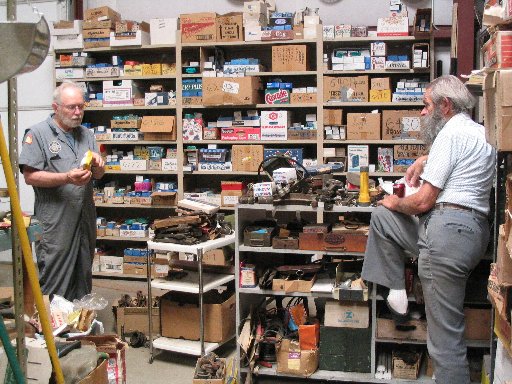
Bill and Lester discussing some Chevy parts. The background is a minute part of Lester's inventory.
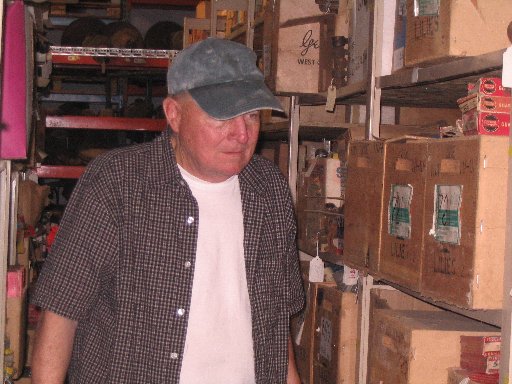
Mike's bewilderment as a result of the overwhelming
amount of parts to chose from in one of Lester's warehouses.
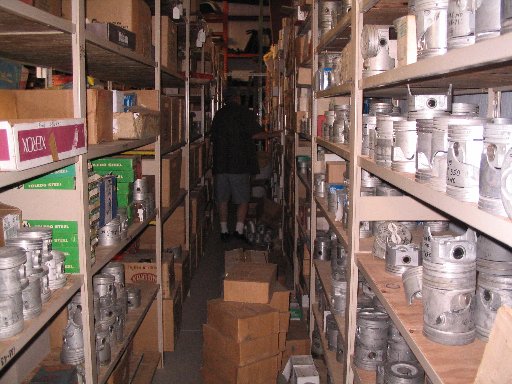
"Pistons?" Did any one say "Pistons."
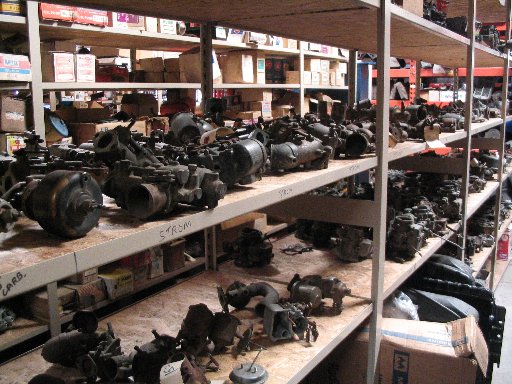
A few antique carburetors to chose from.

Mike and Baxter selecting early 6-cylinder Chevy
rebabbitted connecting rods. There were over 100 to chose from.

"Now let's see, should we be pigs or hogs?"
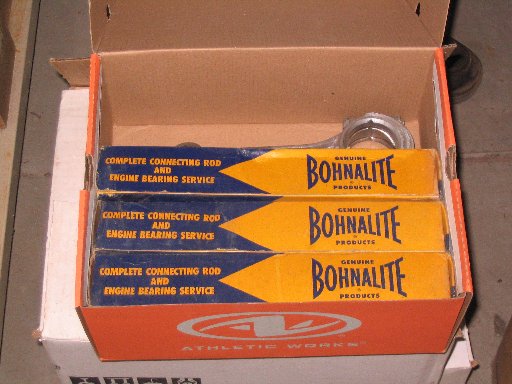
Box after box of connecting rods being packed for their trip home to Billy Possum.
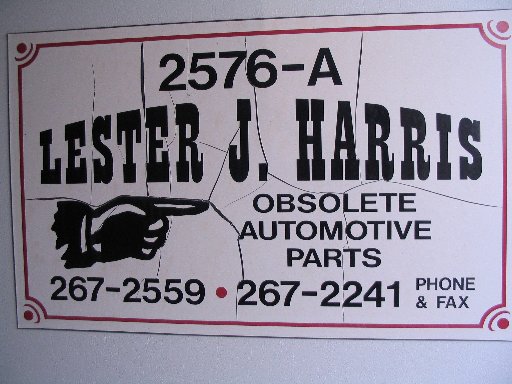
Lester's sign shows the effects of the dry Nevada climate.
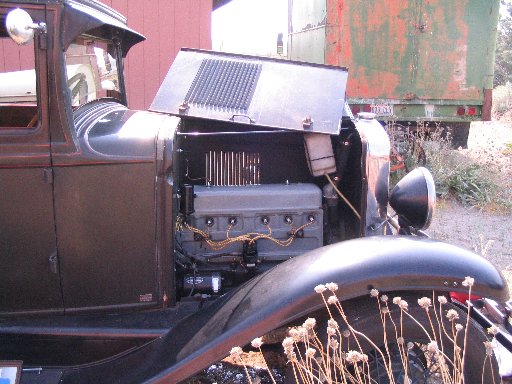
Betsy getting a radiator flush and refill. We used soap in each refill, attempting to clear the grease
that had migrated from the water pump into the cooling system. Later we found a pitted water pump
shaft which caused some of the problems we were having with grease and with water leaks.
Before dinner it was back to Lester's house. The radiator was drained once again and again soap was added to the water. Our problem was thought to be grease in the cooling system, probably from an over-greased water pump.

Another of Mike's clever inventions: a tool box
which slides out from under the passenger's side running board.
Dinner time took us into Carson City. We figured the casinos offered good food at super prices and we were hungry. Seeing a sign advertising a complete prime rib dinner for $5.95 was just what we needed.
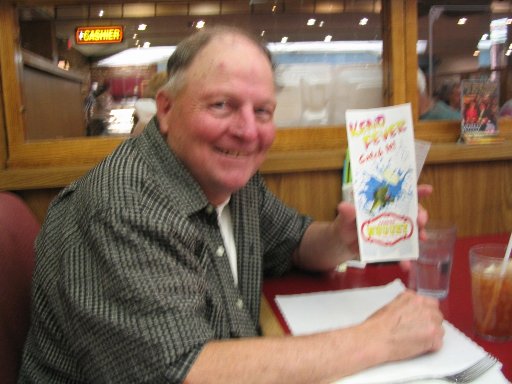
Mike kindly showing the boys what a waste of money gambling is. He spent $1.25 and tipped the girl
selling the tickets $.50. Actually we were here because the complete prime rib dinner only cost $5.95.
When feeding the two chow hounds we brought with us, a bargain dinner was a must.
Wednesday, Day Three
I know that it is hard to believe but even Billy Possum can get tired of looking through old car parts. So we decided to have a sight-seeing day.
After breakfast in Minden, we drove over to Nevada's oldest settlement. Originally named Morman Station, it is now called Genoa. The quaint little village nestles at the very foot of the Sierra Nevada range, that is, at the very westernmost edge of the Carson Valley.
Incidentally, Carson City is actually north of Carson Valley.
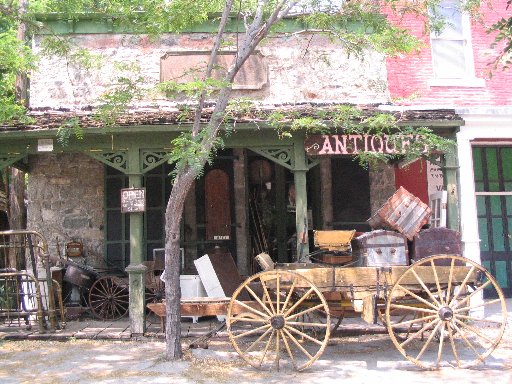
Genoa, Nevada. Nestled against the base of the Sierras in Carson Valley, this quaint little town
was the first permanent settlement in Nevada. It was originally named Mormon Station.
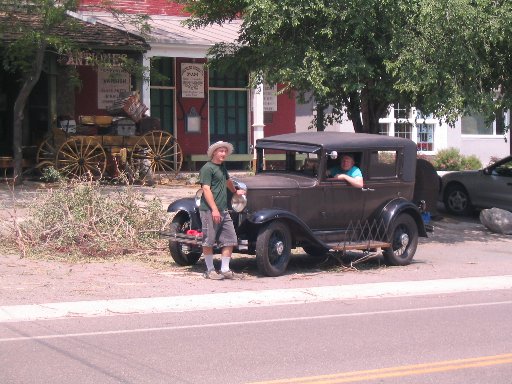
Matthew and Mike waiting for Bill to finish seeing all the sights in Genoa.
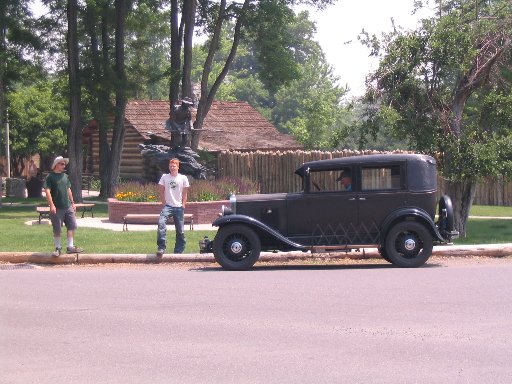
Matthew and Baxter at the site of the original "Mormon Station."
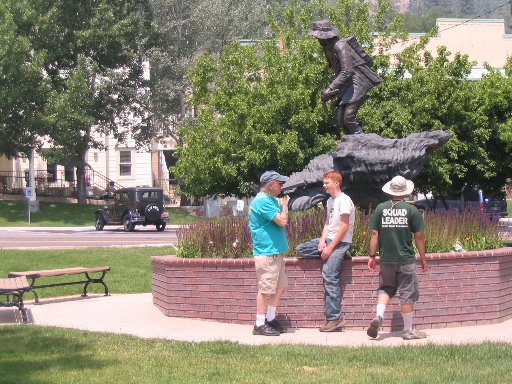
A bronze statue of "Snowshoe" Thompson. He is a legend in Nevada history. He carried
the mail through all kinds of weather. With "Snowshoe" the mail always got through.
After a bit of fooling with the car, we went back to Carson City. The original Carson City Mint building still stands. It is now a really fine museum with all sorts of interesting displays, including a complete collection of the coins struck there. From 1870 to 1893, with a couple of short pauses, the Carson Mint struck coins from the dime to the $20 gold double eagle. The mint served the purpose of turning the enormous amount of silver and no small amount of gold coming from the Comstock Lode into circulating money. Much of the history of Nevada involves Virginia City and the Comstock. Even Samuel Clemens, before he took the name of Mark Twain, worked at the office of the Territorial Enterprise in Virginia City.
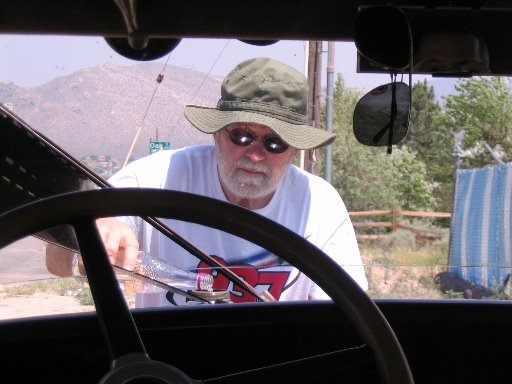
More water for Betsy. This was the beginning of a very persistent problem, partly aggravated
by the leak in the water pump which began to require regular gland tightening.
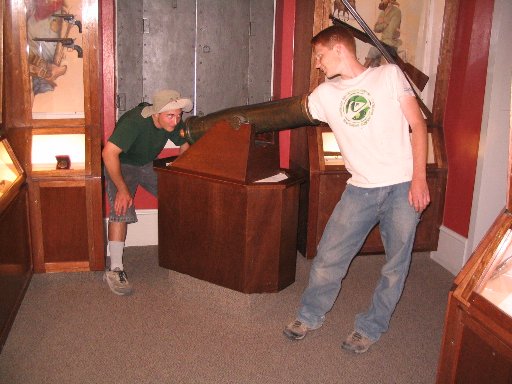
Part of the Carson City Mint Museum gun collection. The boys evidently had too much time on their hands.
One more trip back to the Nugget Casino for another night of prime rib and then the boys were ready to call it a day.
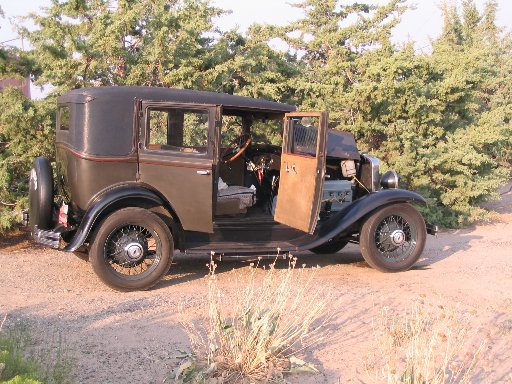
Back from Carson City. More radiator flushing at Lester's.
But before ending the day the boys had to pack up the purchases they made at Lester's. Betsy isn't a truck. Betsy doesn't pull a trailer. So every cranny was filled with car parts, luggage, tools, food and the four boys. With no other space to put parts, even the passenger's running board became a storage area.

Preparing our purchases from Lester.
Soon Betsy's cramped passengers were about to be even more crowded.
The boys just thought the excitement was over, being that it was evening. But Lester's offer of a ride in his 1926 Rolls Royce couldn't be passed up. The car's body had been hand made by coach builders for the wife of an executive in France. Nothing was spared.
While Bill rode in the chauffeur's front seat with Lester, Mike, Baxter and Matthew rode inside in what was pure luxury.
One of the surprising things about this car was the power. The car could easily keep up with traffic on the open road. And the ride was really comfortable. It was, indeed, a real treat to end the day.
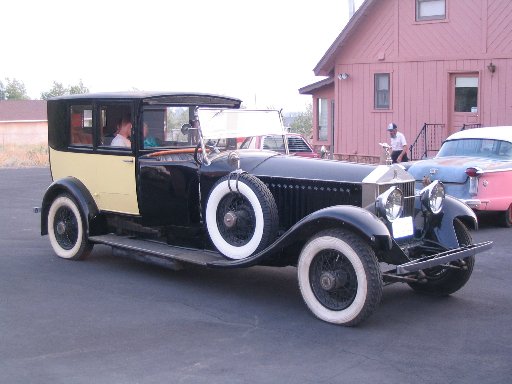
Lester offered a ride in his 1926 Rolls Royce. The car had originally been custom made
for the wife of the man in charge of Woolworth's in France.
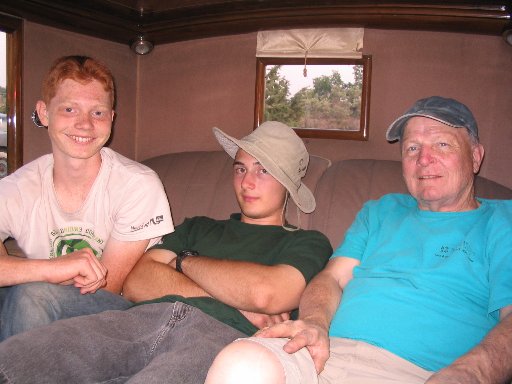
This ain't no Chevy! The boys enjoying the luxury that they weren't used to in Betsy.

Baxter checking out the driver's seat in the Rolls.
Thursday, Day Four
Our plan was to leisurely drive from Lester's to Bishop and spend the night. Then on Friday we would drive home, arriving in Los Angeles after the end-of-week traffic had subsided.

They named a road in Minden for Billy Possum! Well, of course!
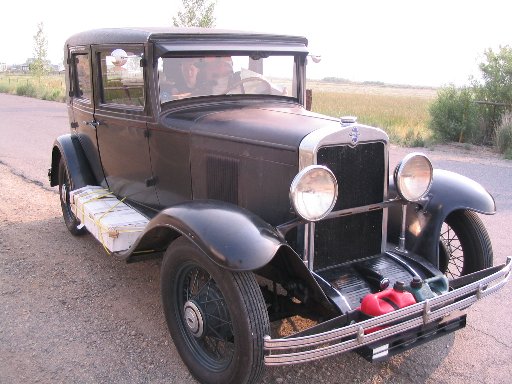
The beginning of the trip home. Even the passenger's running board had parts boxes on it.

Not to be outdone by Billy Possum, Mike also had a street named after him.
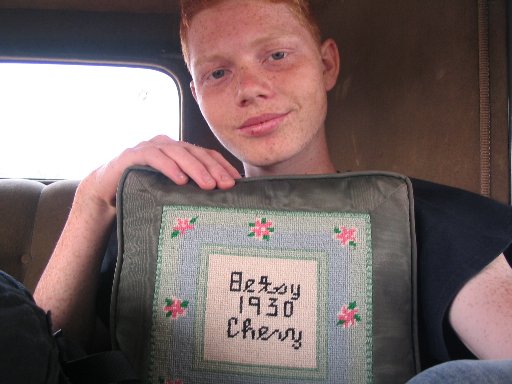
Just to let you know that the following problems did not happen to "Bomber."

What would a trip to Nevada be without a stop over in Smith Valley
where Bill moved when he was 13 years old.
So we said "Goodbye" to Lester and headed south. At the Holbrook Junction we turned east and drove to Smith Valley, where Bill had lived as a teenager. Entering the valley and passing through the tiny town of Wellington, we drove by the ranch that Bill's dad had owned in the 1950's, and on into Smith, the little town known as Central to the locals. After a few minutes listening to the farmers talk of water rights, politics in general and the price of gas, we again headed east to Wilson Canyon.
Incidentally, one of the farmers at Central had said that it used to take 1 pound of beef on the hoof to pay for a gallon of gas. Now it takes 4 pounds!
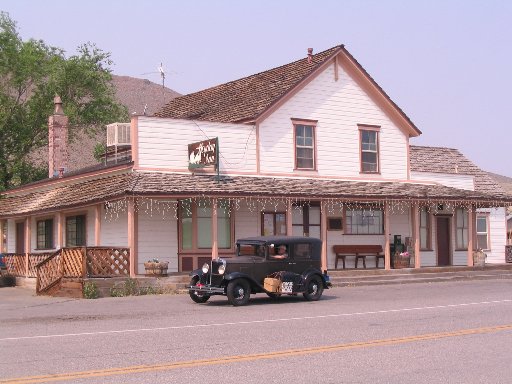
Smith Valley's finest: the only place to eat in Wellington. It is open every once in a while.
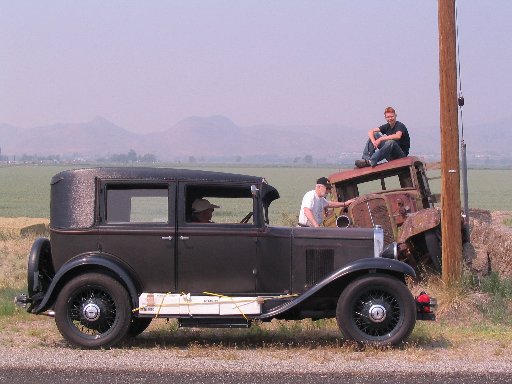
Very close to Bill's old ranch home. Baxter may become a Chevy guy after all.

Bill's old ranch. The building at the right is the old "granary
where Bill used to mix food for the pigs and the one milk cow.

In the town of Smith, normally referred to as "Central" (population about 5).
What used to be an automotive garage is now a hardware and equipment store.
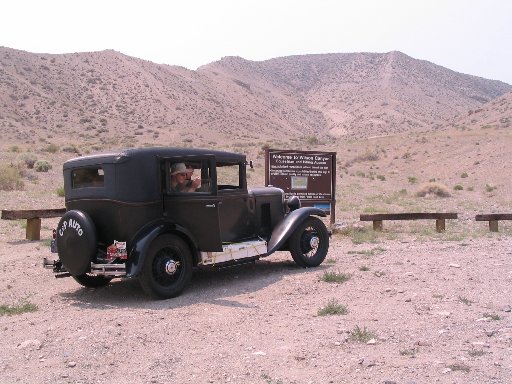
Wilson Canyon, between Smith and Mason Valleys.
The purpose of going to Wilson Canyon was to let the boys stretch their legs and also to let them try to find a bit of the petrified wood that lies on one of the hillsides.

Hiking over a ridge in Wilson Canyon the boys climbed the peak on the next ridge.
Then they found some petrified wood on the face just to the lower right of where they are standing.
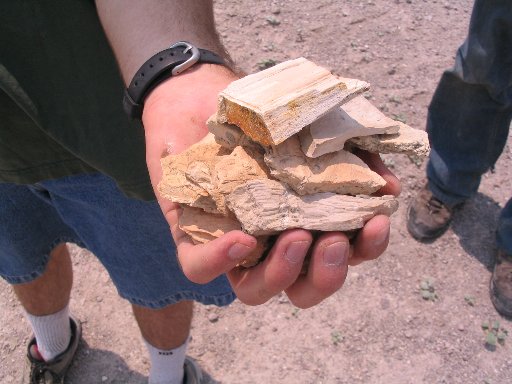
Petrified wood. Bill had gone to the same place 58 years before.
From Wilson Canyon the boys headed back to Central, turned south and spent the next hour of so driving down the Sweetwater road to Bridgeport. After lunch in Bridgeport the journey was fairly routine, going down the Conway grade, again stopping for ice cream in Crawley and then over Deadman's Summit and down the Sherwin grade.
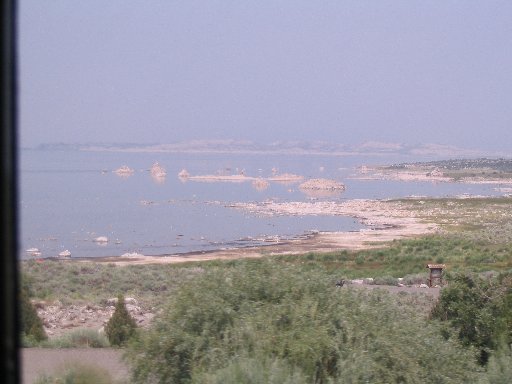
Mono Lake was almost lost in the haze from all of the California fires.
While in Crawley we called ahead and cancelled our motel reservations in Bishop. Considering the overheating problems we were experiencing, it made more sense to us to drive through the night and arrive home while it was still cool rather than stop in Bishop and drive in the heat of the morrow across the desert.
So a stop for gas in Bishop was the only pause until Lone Pine, where the boys had dinner. The time was about a quarter to 8 pm when they proceeded south.
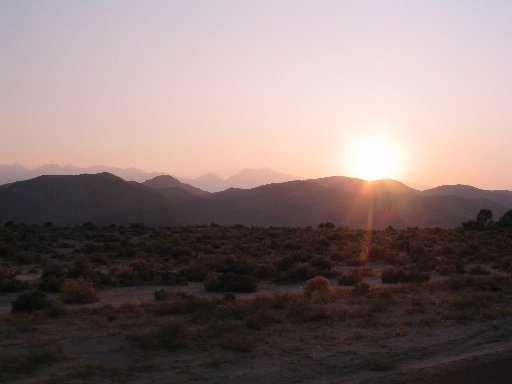
The end of another day on the road. Having cancelled our reservations in Bishop
the intent was to drive all the way to Los Angeles in the cool of the night.
At first there was only an occasional miss to the engine but about 10 miles south of Lone Pine the engine decided it wasn't going to cooperate with our plans to keep going. After a short consultation the fuel pump was changed and the engine started right up and ran great. So off we went again. It was still light when we stopped but it had turned dark as we finished changing the fuel pump.
Incidentally, the fuel pump was an old one that did not have a Billy Possum diaphragm in it. Clearly an oversight!
We passed Olancha, Little Lake and even Red Rock without a problem but then again an occasional miss in the engine quickly developed into a serious problem. Though the engine would run, it certainly wasn't going to take us where we wanted to go.
The time was about 11 pm and we were about 20 miles short of Mojave. Even though it didn't seem like it could be the fuel pump we took the top of the original fuel pump and the bottom of the replacement pump and put them together. That didn't work. The engine still ran awful. We decided to change the carburetor but that didn't help either.
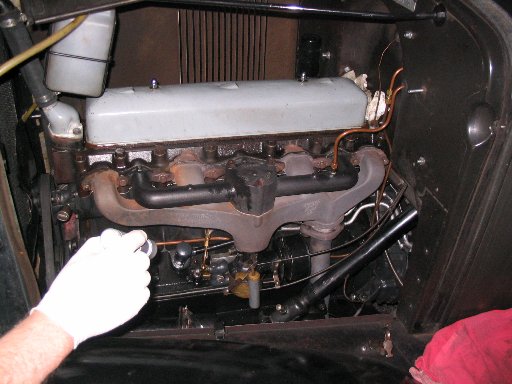
The second time the engine said "That's it, boys."
The time was about 11:30 p..m.about 20 miles north of the town of Mojave.
While we were finishing up with the carburetor change the California Highway Petrol showed up. The officer was extremely helpful and offered to call the Triple-A tow truck. We were tired. It was late. So we accepted his offer. It was about 1 am when the tow truck arrived.

Betsy being loaded onto a AAA truck for a "tow" into Mojave.
The tow truck driver was really super. Betsy was loaded on the back of the truck and all 4 of us squeezed into the truck cab for the ride to Mojave.
Once in Mojave the driver took us to a motel but it was full. Then another full motel. Finally we found a motel that had a vacancy and we were about ready to take a room when Mike found that there were no phones in the rooms. We had to have a phone available. Then Bill saw another motel about a block away, ran down to it and found that there was a vacancy with phone!
Betsy was unloaded and rolled into the parking place right in front of our room and we thanked the tow truck driver for such excellent help.
My wife was expecting us that night so I phoned to tell her of our predicament. She said she would phone when she woke up the next morning.
It didn't take very long for all of us to get to sleep that night.
Friday, Day Five
Apparently the phone rang before 6 am. I was sound asleep but my wife had not slept well at all and she called to get instructions on what to bring with her in the old Ford. Referred to as the "Beast," the tow car is a 1985 Ford LTD station wagon. It has got us out of several jams and this would be one more save for the old beast.
Our tow bar bolts directly onto the front frame rails after the bumper has been removed. In addition to the tow bar my wife brought the wooden bar with the tail lights. We tape it to the rear bumpers and the cables are then run to the front of the car, strapped to the tow bar and then are plugged into the Ford's light system. She also brought the wrench to remove the front bumper and several other tools.
She left home, about 100 miles south of Mojave, about 6 am.
The motel phone rang. "I'm in Palmdale and the car stopped." My wife has a cell phone the kids gave her just in case of an emergency. Unable to swerve out of the way because of traffic she had straddled a piece of a tire in the road. It had came up under the car and went bang! And the "Beast" just quit! Our rescue car was miles away. And it wouldn't go!
Ford designed a switch in the fuel line that turned off the fuel pump if ever their was a collision. The switch is very sensitive as illustrated by the present incident.
The problem was to find the switch.
There is a glove box-like compartment in the side of the station wagon interior near the rear of the car. "Open it up and take out all of the stuff. Find a little hole in the side of the compartment and feel for a switch." A moment later my wife said the car was running again and everything seemed alright. She would continue on.

The following morning in Mojave. Matthew preparing for the tow home.

This is not the way we planned to have our trip end. Bill's wife had driven
the tow vehicle up to Mojave from Los Angeles. Yes, we were in deep yogurt!
When my wife showed up she was in a far better mood than anyone could expect. Don't get me wrong, she wasn't jolly happy. But she had rescued us (again!!).
We hooked up the rig and began the tow home.
I think it was in Palmdale that we stopped for breakfast. Then on the road again. The tow went fairly well although the grade out of Palmdale is fairly steep and Betsy didn't tow particularly well. So the drive was slow but safe, and we arrived home somewhat before noon.
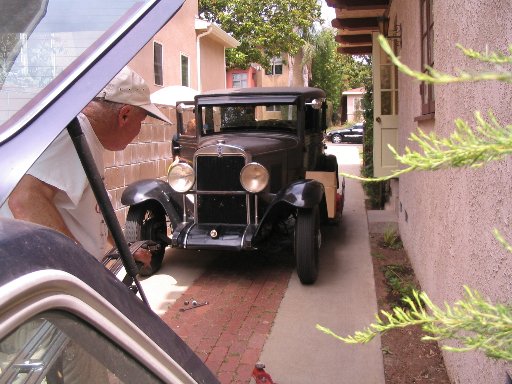
Home at last. Actually we arrived earlier in the day than we had planned.
The rig was separated and Betsy's bumper was returned to the front of the car. Our purchases were taken to the parts department, the tools were put away, along with the tow bar and lights, our personal bags were unloaded and Betsy was pushed into a parking space in the back of my house. Another "Car Trip" was over.
Janice, Mike's wife, came to pick up Mike. She also had very kindly brought dinner for Bill, Jeanette and the two grandsons.
Postscript
Monday Mike came back to remove the cylinder head from Betsy. Bill had already taken off the the rocker arm assemblies, the push rods, water pump and manifolds. We suspected the worst because somewhere along the way home we saw a fine mist of miniature bubbles when the radiator cap was removed. Later Bill had seen more than miniature bubbles - quite a bit of combustion gas bubbling into the radiator. And the overflow tank would no longer return coolant to the radiator when the engine was shut off.

Removing the valves from Betsy's cylinder head.
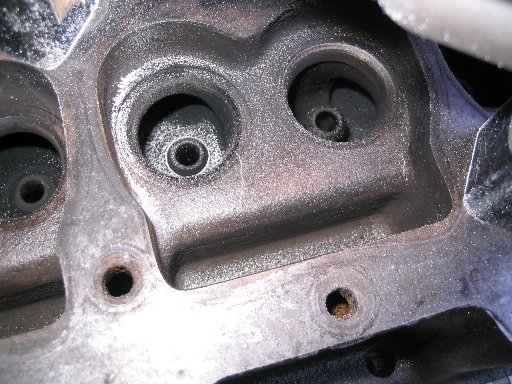
The bad news. With the Magnaflux powder dusted on Betsy's cylinder head the crack is clearly visible..
Sure enough, with all of the valves removed and the hand-held magnafluxer turned on we found a crack across one of the exhaust valve seats.
After much discussion and consultation with many of our friends it was decided to have the head repaired by pinning. We made the decision based on two factors: 1) We need to find the overheating problem and fix it once-for-all and we would rather risk further damage to a repaired head rather than on a cylinder head that had not been damaged. 2) No undamaged 1930 cylinder head could be had anywhere.
Actually we have 2 other 1930 cylinder heads, one for an engine being built up and another which is used to illustrate all of our "Original Billy Possum Brand" upper engine parts such as rocker arm shaft & bushing sets, adjuster screws & locking nuts and push rods & push rod ends. We didn't consider either of these heads as available for Betsy.
In hind sight we hadn't checked out Betsy thoroughly enough after last year's trip to Minden. When the repairs are finished Betsy will be tested on one or more rigorous hill climbs before any longer trips are planned.
After all, we can always take old reliable "Bomber," Bill's 1929 Chevy.
C&P AUTOMOTIVE
New Address:
5472 N. Martha Loop
Coeur d'Alene, ID 83815
Same old Phone Number:
(310) 454-0015
Email:BJChestwood@gmail.com
